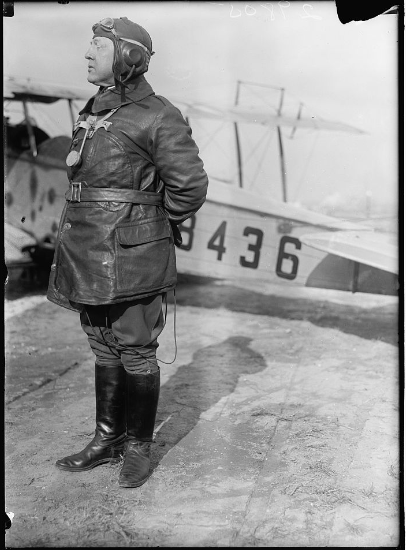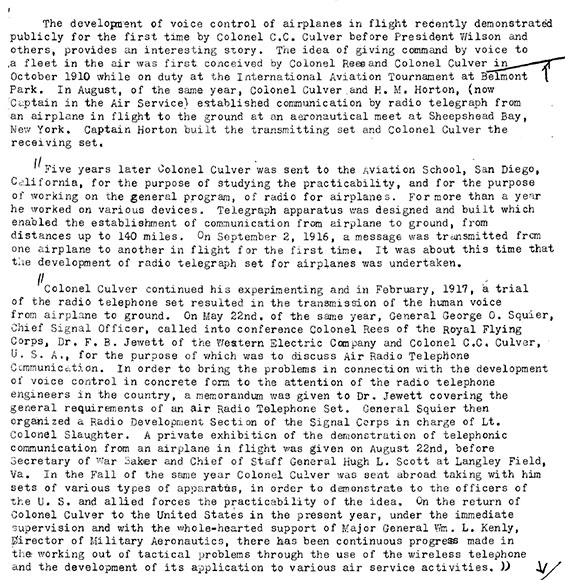|
"Romeo" "Alpha" "Delta" "India" "Oscar":
The
Man Who Enabled "Roger" and "Wilco"
An "Action" Shot of C.C. Culver!
 |
Clarence Curtis Culver was born in Milford, NB December
25, 1872. He signed the Davis-Monthan Register three times
between 1929 and 1932. He was one of the oldest military
pilots to land at Tucson. At the date of his
last signing, in 1932, he would be nearing 60 years
old.
Clarence C. Culver, Date & Location Unknown (Source: LOC)
 |
Regardless of his age, he was one of the early prolific
contributors to the fundamental concepts and technologies
of aviation radio communications. He attended the University
of Nebraska and graduated in 1898 with a degree in electrical
engineering. This is what set him up for his military achievements
with air-to-air and air-to-ground communications. See this link for
another action image of C.C. Culver in this regard.
Image, right, is from the Library of Congress (LOC). It shows Culver, date and location unidentified, with earphones in his helmet and a chest-mounted microphone around his neck. Note the wire looped past his left knee. I was unable to come up with an identification of the airplane behind him, and I saw no obvious antenna arrays attached to it for radio reception or transmission.
At the University, he was in charge of the University Weather
Station as well as the electrical service system. The weather
station at the time was important in providing
farmers with weather information, not aviators. After college
he joined the military and served in the 3rd Cavalry during
the Spanish American War. He became a 2nd lieutenant in 1901
and served in the U.S. and Philippines. He entered
the Signal Corps in 1907 and remained until 1911.
He began experiments in 1910 with airplane wireless communications.
He personally designed and built the receiving apparatus
used for these experiments,
which resulted in successful air-to-ground transmission of
code. In October 1910 he proposed the feasibility of developing
airplane radio telephone and voice-commanded flying.
The
experiments continued. During 1915-16 he accomplished long distance radio
transmission from airplanes up to 140 miles with .20 kW power
and developed a means of insulating engine magneto sounds
from send and receive communications in flight. He successfully
exchanged coded messages between airplanes in flight. Then
he studied dictaphone recordings of speech made in flight
and reported on the practicability of telephonic speech in
the noisy environment of airplane engines under full power
in the air.
In June 1916 he built with E.J. Simon, a New York radio
engineer, a radio telephone set embodying results of his
experiments of 1915-16. In February, 1917 this set transmitted
the human voice for the first time from an airplane in flight.
In May he was sent to Europe to demonstrate the radio equipment
and to investigate the requirements radio equipment should
meet in combat. His efforts were summarized in the Air Corps Newsletter of December 14, 1918, below.
C.C. Culver in the Air Corps Newsletter, December 14, 1918 (Source: Webmaster)
 |
He was detailed
to aviation duty and learned to fly in 1916, becoming a
"Junior Military Aviator" in 1917, and "Airplane Pilot" in
1920. He was put in charge of matters pertaining to radio
and communications through 1925 when he became Commanding
Officer of Kelly Field, TX.
He received the Medal of Merit
(1916), the Distinguished Service Medal (1919) and the civilian
Certificate of Merit (1919) from the Aero Club of America,
all for his activities related to aviation radio communications.
By 1931, radio was used to control all 670 military aircraft
of the Air Division then under the command of General
Foulois. See also Register pilot Albert Hegenberger for one important utility coming out of Culver's work with radio communications.
He retired on January 31, 1934 having spent 34 years in
continued commissioned service of which 18 years and 5 months
were spent in aviation. He had soloed most of the types and
models of military aircraft. He died June 19, 1946 and is buried at the Arlington National Cemetery, Plot Section 4, Site 3028-B.
---o0o---
Image below of male members of the Culver family
(see credit in right sidebar). The patriarch is Jacob Hazel
Culver at center, himself a Brigadier General.
Jacob Culver is surrounded by his four sons,
all in uniform. Clarence C. Culver
is in the upper left corner; brother Elwin E. Culver is in
the upper right corner; Register passenger Harry H. Culver is in the lower left
corner; and brother Fred D. Culver is in the lower right
corner. Although the image is undated, it is probably sometime
in the 1890s-early 1900s.
Culver Pere et Frere
 |
---o0o---
Dossier 2.2.63
THIS PAGE UPLOADED: 01/09/07 REVISED: 01/10/07, 01/12/09, 02/03/16, 06/25/18
|





